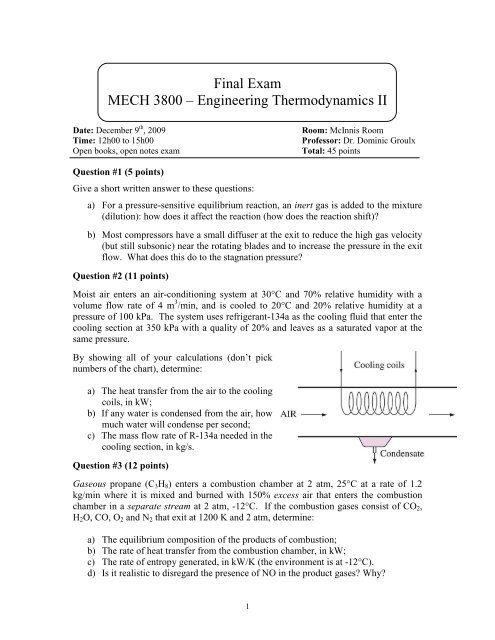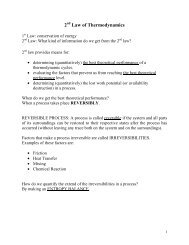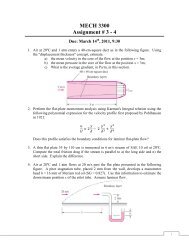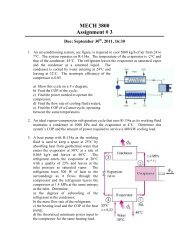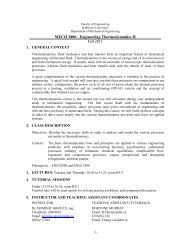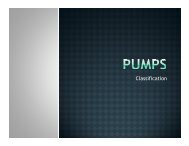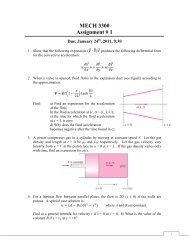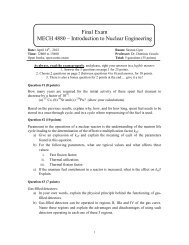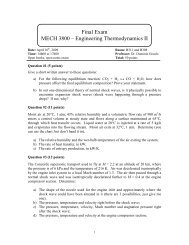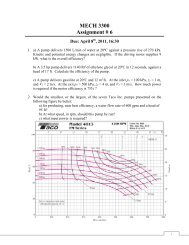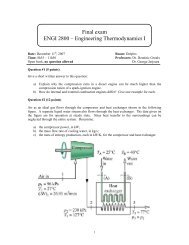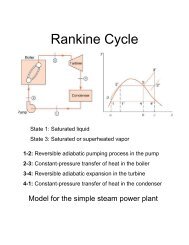Final Exam MECH 3800 â Engineering Thermodynamics II
Final Exam MECH 3800 â Engineering Thermodynamics II
Final Exam MECH 3800 â Engineering Thermodynamics II
Create successful ePaper yourself
Turn your PDF publications into a flip-book with our unique Google optimized e-Paper software.
<strong>Final</strong> <strong>Exam</strong><br />
<strong>MECH</strong> <strong>3800</strong> – <strong>Engineering</strong> <strong>Thermodynamics</strong> <strong>II</strong><br />
Date: December 9 th , 2009<br />
Time: 12h00 to 15h00<br />
Open books, open notes exam<br />
Room: McInnis Room<br />
Professor: Dr. Dominic Groulx<br />
Total: 45 points<br />
Question #1 (5 points)<br />
Give a short written answer to these questions:<br />
a) For a pressure-sensitive equilibrium reaction, an inert gas is added to the mixture<br />
(dilution): how does it affect the reaction (how does the reaction shift)?<br />
b) Most compressors have a small diffuser at the exit to reduce the high gas velocity<br />
(but still subsonic) near the rotating blades and to increase the pressure in the exit<br />
flow. What does this do to the stagnation pressure?<br />
Question #2 (11 points)<br />
Moist air enters an air-conditioning system at 30°C and 70% relative humidity with a<br />
volume flow rate of 4 m 3 /min, and is cooled to 20°C and 20% relative humidity at a<br />
pressure of 100 kPa. The system uses refrigerant-134a as the cooling fluid that enter the<br />
cooling section at 350 kPa with a quality of 20% and leaves as a saturated vapor at the<br />
same pressure.<br />
By showing all of your calculations (don’t pick<br />
numbers of the chart), determine:<br />
a) The heat transfer from the air to the cooling<br />
coils, in kW;<br />
b) If any water is condensed from the air, how<br />
much water will condense per second;<br />
c) The mass flow rate of R-134a needed in the<br />
cooling section, in kg/s.<br />
Question #3 (12 points)<br />
Gaseous propane (C 3 H 8 ) enters a combustion chamber at 2 atm, 25°C at a rate of 1.2<br />
kg/min where it is mixed and burned with 150% excess air that enters the combustion<br />
chamber in a separate stream at 2 atm, -12°C. If the combustion gases consist of CO 2 ,<br />
H 2 O, CO, O 2 and N 2 that exit at 1200 K and 2 atm, determine:<br />
a) The equilibrium composition of the products of combustion;<br />
b) The rate of heat transfer from the combustion chamber, in kW;<br />
c) The rate of entropy generated, in kW/K (the environment is at -12°C).<br />
d) Is it realistic to disregard the presence of NO in the product gases? Why?<br />
1
Question #4 (13 points)<br />
A CO 2 cartridge is used to propel a small rocket cart. Compressed gas, stored at 18 MPa<br />
and 20°C, is expanded through a smoothly contoured converging nozzle with 0.5 mm<br />
throat diameter. The back pressure is atmospheric at 101 kPa.<br />
a) Calculate the pressure and temperature at the nozzle throat when the compressed<br />
air is released initially;<br />
b) Evaluate the mass flow rate of carbon dioxide through the nozzle;<br />
c) Determine the thrust available to propel the cart;<br />
d) How much would the thrust increase if a diverging section was added to the<br />
nozzle to expand the gas isentropically to atmospheric pressures?<br />
e) What would be the diameter of the exit area of the diverging section and the exit<br />
temperature in that case?<br />
Question #5 (9 points)<br />
For the converging-diverging nozzle presented on the following figure, determine the<br />
back pressure necessary for the shock wave to position itself as shown at section s.<br />
Assume that the fluid is air.<br />
Also, if the flow exits with a temperature of 25°C, what was its temperature and velocity<br />
at section 1?<br />
…. enjoy your holidays<br />
2


